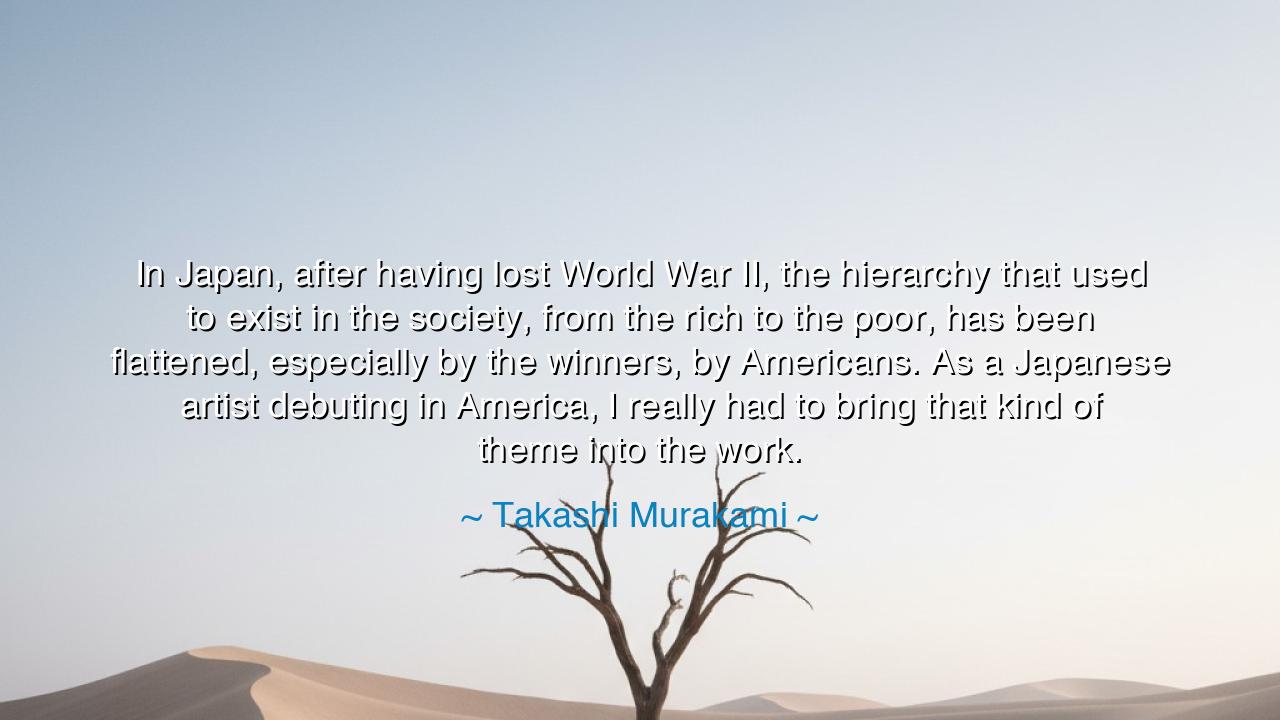
In Japan, after having lost World War II, the hierarchy that used
In Japan, after having lost World War II, the hierarchy that used to exist in the society, from the rich to the poor, has been flattened, especially by the winners, by Americans. As a Japanese artist debuting in America, I really had to bring that kind of theme into the work.






"In Japan, after having lost World War II, the hierarchy that used to exist in the society, from the rich to the poor, has been flattened, especially by the winners, by Americans. As a Japanese artist debuting in America, I really had to bring that kind of theme into the work." These words by Takashi Murakami reflect on a deep transformation in both Japanese society and the world of art after the destructive aftermath of World War II. Murakami’s insight speaks to the shifting dynamics of power, identity, and culture—the radical change in Japan's social structure following its defeat. The hierarchical system that once stood firm from the rich to the poor was restructured, influenced largely by the Americans—the victors of the war—who imposed new values that flattened the rigid social order. As Murakami suggests, this dramatic social change would be a profound influence on his work as an artist in the United States, where he could blend Eastern themes with the Western ethos that had reshaped Japan’s society.
In the ancient world, the role of hierarchy was also a significant aspect of society. Consider the Egyptians, where the pharaoh stood at the very top, considered not just a king but a god. The social order was rigid and unbending, with those in the lower echelons of society having limited opportunities for upward mobility. Yet, even in the height of Egyptian power, there was an underlying recognition that change could come, though it was often disruptive and violent. Alexander the Great’s conquest of Egypt brought with it a shift in power dynamics, symbolizing how the victors can radically transform the cultural and social fabric of a society. But while change was inevitable, it was often accompanied by tension, as those in power sought to maintain control, while the defeated struggled to adapt to new, foreign influences.
The social hierarchies that Murakami speaks of were deeply ingrained in Japanese culture. For centuries, Japan was governed by a strict feudal system, with the samurai at the top and the peasants at the bottom. The defeat of Japan in World War II disrupted this long-standing order. American occupation, led by General Douglas MacArthur, introduced profound reforms, including the drafting of a new constitution that granted universal suffrage and dismantled the military-based feudal hierarchies that had previously defined Japan. This was not merely a shift in governance—it was a cultural upheaval that flattened centuries of established norms, where the rich no longer held the exclusive power, and new possibilities opened up for the lower classes. Murakami, growing up in post-war Japan, witnessed this transformation firsthand, and it shaped his art, reflecting themes of egalitarianism, identity, and the blurred lines between the high and the low.
Murakami’s own rise as an artist parallels this flattening of hierarchical structures. His work, often characterized by its fusion of traditional Japanese motifs with pop culture influences, challenges the division between high art and low culture. In this, he embodies the very transformation that Japan underwent after the war. Just as Japan’s social hierarchy was dissolved by external forces, Murakami’s art aims to dissolve the traditional barriers between fine art and mass production, between elite culture and popular expression. His works, which often feature cartoon-like characters and bold, colorful imagery, are a reflection of this flattening of distinctions—both between classes and between the traditional and the modern.
Consider the rise of Pop Art in the West, particularly figures like Andy Warhol and Roy Lichtenstein, who blurred the lines between art and advertising, consumer goods, and mass media. Warhol’s famous Campbell’s Soup Cans broke down the hierarchy that once placed fine art on a pedestal, elevating the mundane and the commercial to the level of high art. This revolution in artistic philosophy was not unlike the transformation that Murakami witnessed in post-war Japan—a society in which the old hierarchies were overturned, giving way to new forms of expression that mixed the elite and the common, the sacred and the profane.
The lesson of Murakami’s reflection is a powerful one: the notion of hierarchy, once seen as an unshakable element of any society, can be radically altered. When society undergoes a drastic shift, whether through war, political revolution, or cultural change, the roles and structures that once governed a nation’s identity can be flattened, creating space for new forms of expression and new opportunities for those who were previously marginalized. Murakami’s art reflects this democratization of culture, where the boundaries between high and low are blurred, and where anyone, regardless of social standing, can engage with the artistic and cultural conversation.
In our own lives, we must ask: How are we participating in this flattening of hierarchies? Are we challenging the distinctions between high culture and low culture, between the elite and the common? Are we open to change and to the possibility that old structures—whether in society, art, or ideas—might need to be redefined in order to reflect a more equitable and inclusive world? Let us embrace the wisdom of Takashi Murakami and remember that society, like art, is always in a state of transformation. When the hierarchies we have accepted as natural are dismantled, new possibilities arise. It is up to us to shape what comes next, using our collective creativity and vision to build a world where barriers are not just flattened, but replaced with the power of unity and shared expression.






AAdministratorAdministrator
Welcome, honored guests. Please leave a comment, we will respond soon